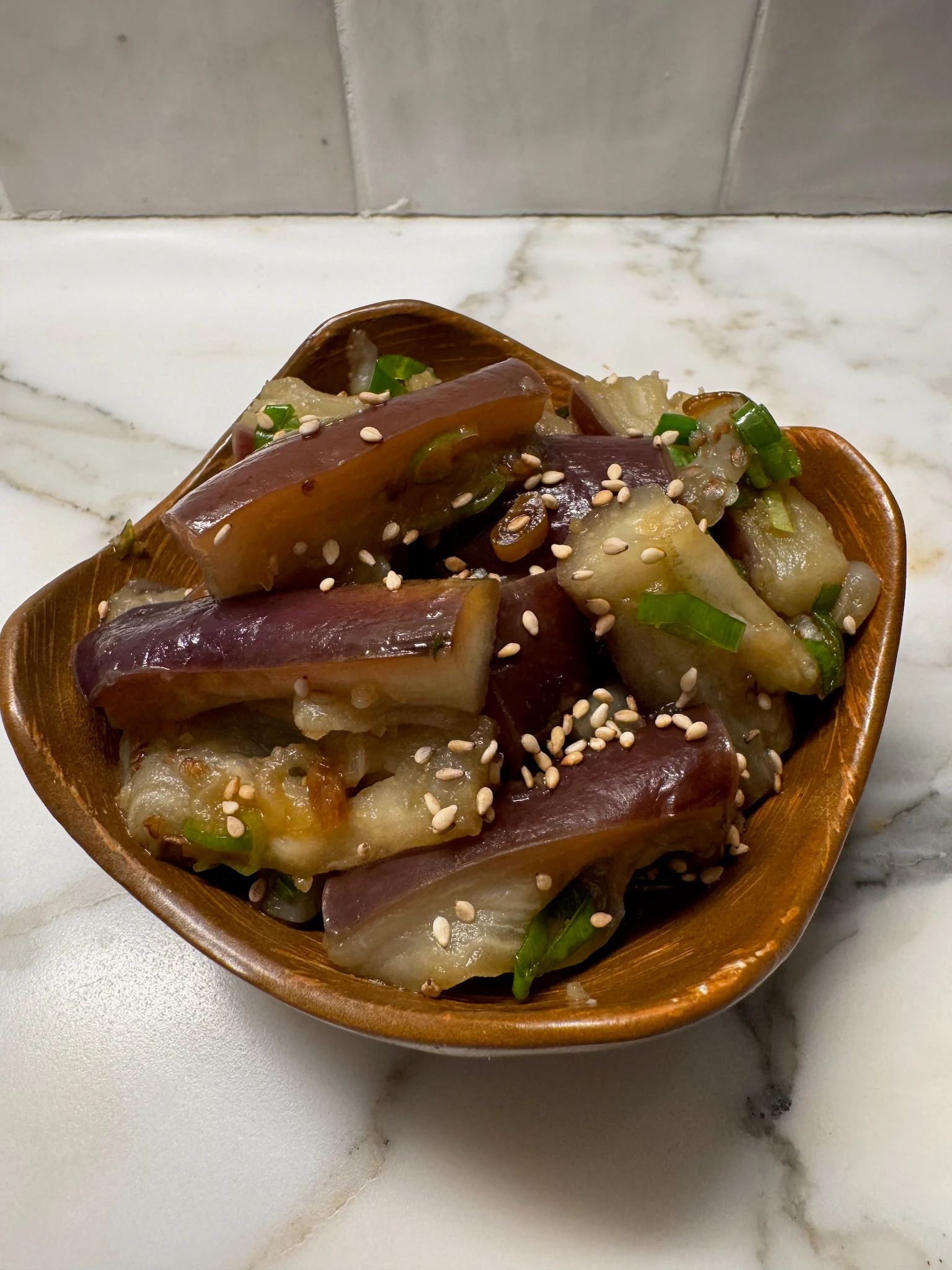Gaji namul represents the essence of Korean vegetable preparation, where eggplant is transformed through blanching and seasoning into a silky, flavorful korean seasoned eggplant banchan. This dish exemplifies the Korean tradition of namul (seasoned vegetables), where simple cooking techniques and careful seasoning create vegetables that are both nutritious and delicious. In Korean homes, this preparation method has been passed down through generations as a way to make vegetables both appealing and nourishing.
What makes gaji namul particularly special is its silky texture and ability to absorb flavors while maintaining its delicate nature. The eggplant is first blanched to achieve the perfect tenderness, then seasoned with a balance of garlic, sesame oil, and soy sauce that enhances its natural qualities. This dish demonstrates the Korean culinary principle of allowing vegetables to shine while adding complementary seasonings.
In modern Korean dining, gaji namul continues to be a popular banchan that showcases the beauty of Korean vegetable preparation. Whether served at home or in restaurants, this seasoned eggplant provides a light, flavorful addition to any Korean meal while offering a healthy, vegetable-based option that appeals to various dietary preferences.
Why You’ll Love This Recipe
- Light and healthy
- Silky smooth texture
- Simple ingredients
- Quick preparation
- Naturally vegan
- Perfect summer banchan
What is Gaji Namul?
Gaji namul (가지나물) is Korean seasoned eggplant where eggplant is blanched until tender and then seasoned with garlic, soy sauce, and sesame oil. The name combines “gaji” (eggplant) with “namul” (seasoned vegetable), creating a light, flavorful banchan.

Korean Seasoned Eggplant
Ingredients
For the Eggplant:
- 2 Asian eggplants
- 2 tsp salt
- Water for blanching
For the Seasoning
- 2 cloves garlic minced
- 2 green onion(s) finely chopped
- 2 tsp soy sauce
- 1 tbsp sesame oil
- 1 tsp korean red pepper flakes (gochugaru)
- 1 tbsp sesame seeds
- ¼ tsp black pepper
Instructions
Prepare the Eggplants:
- Begin by washing the eggplants thoroughly under cool water
- Cut off the stems and slice each eggplant lengthwise into quarters
- Then cut these quarters into 2-inch pieces at a slight diagonal
- Place the cut eggplant in a colander and sprinkle with 2 tsp salt
- Gently toss to coat evenly and let sit for 15 minutes to draw out moisture
- This salting step is crucial for removing any bitterness and improving texture
Blanching Process:
- While the eggplant is salting, bring a large pot of water to a rolling boil
- Rinse the salted eggplant pieces thoroughly under cold water
- Gently squeeze out excess water with your hands
- Carefully add the eggplant to the boiling water
- Cook for 3-4 minutes, or until the eggplant is tender but still holds its shape
- You’ll know it’s ready when a piece easily yields to chopsticks but doesn’t fall apart
- Immediately drain in a colander and shock in ice water to stop the cooking
Prepare for Seasoning:
- Once cooled, gently squeeze the eggplant pieces between your palms
- Work with small amounts at a time, being careful not to crush them
- Place the squeezed pieces in a mixing bowl
- The goal is to remove excess water while maintaining the eggplant’s shape
Season the Eggplant:
- In a separate small bowl, combine minced garlic and chopped green onions
- Drizzle 1 tbsp of sesame oil over the vegetables and mix well
- This helps the aromatics bloom and release their flavors
- Add the seasoned garlic and green onions to the eggplant
- Pour in the soy sauce and remaining sesame oil
- Using your hands (wear gloves if desired), very gently toss the eggplant
- The goal is to coat each piece evenly while keeping them intact
- Each piece should glisten with the seasonings
Final Touches:
- Sprinkle with toasted sesame seeds
- Add gochugaru if using, starting with a small amount
- Add black pepper
- Give everything one final, gentle toss
- Taste and adjust seasonings as needed
- Remember the flavors will develop as it sits
Resting Period:
- Let the seasoned eggplant rest at room temperature for 30 minutes
- This allows the flavors to meld and develop
- During this time, the eggplant will absorb the seasonings
- The texture will also continue to improve
- Taste again after resting and adjust seasonings if needed
Notes
Recipe Tips
- Don’t overcook eggplant
- Squeeze water thoroughly
- Season while warm
- Use fresh eggplants
- Adjust garlic to taste
- Keep pieces uniform size
Serving Suggestions
Serve with:- Steamed rice
- Other banchan
- Korean main dishes
- As side salad
- In bibimbap
- With grilled meats
Variations
- Spicy version
- Steamed instead of blanched
- Different eggplant varieties
- Add mushrooms
- Include carrots
- Grilled version
Storage
- Keeps 3-4 days refrigerated
- Store in airtight container
- Serve at room temperature
- Don’t freeze
- Best eaten within 2 days
Nutrition
Find more great Nosh With David Recipes, including authentic Korean recipes like this one, at https://www.noshwithdavid.com/recipes/
Key ingredients from this recipe include:
Sempio Soy Sauce
Kadoya Sesame Oil
Shirakiku Roasted Sesame Seeds
Taekyung Korean Chili Flakes
Need help with what ingredients to stock? Check out My Essential Korean Pantry article. This article describes each essential ingredient with links to where you can buy them easily!


Leave a Reply